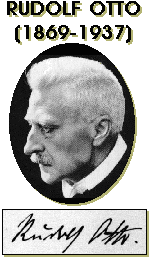Rudolf Otto's Concept of the "Numinous"
 Otto was one of the most influential thinkers about religion in the first
half of the twentieth century. He is best known for his analysis of the
experience that, in his view, underlies all religion. He calls this experience
"numinous," and says it has three components. These are often designated
with a Latin phrase: mysterium tremendum et fascinans. As mysterium,
the numinous is "wholly other"-- entirely different from anything we experience
in ordinary life. It evokes a reaction of silence. But the numinous is
also a mysterium tremendum. It provokes terror because it presents
itself as overwhelming power. Finally, the numinous presents itself as
fascinans, as merciful and gracious.
Otto was one of the most influential thinkers about religion in the first
half of the twentieth century. He is best known for his analysis of the
experience that, in his view, underlies all religion. He calls this experience
"numinous," and says it has three components. These are often designated
with a Latin phrase: mysterium tremendum et fascinans. As mysterium,
the numinous is "wholly other"-- entirely different from anything we experience
in ordinary life. It evokes a reaction of silence. But the numinous is
also a mysterium tremendum. It provokes terror because it presents
itself as overwhelming power. Finally, the numinous presents itself as
fascinans, as merciful and gracious.
Outline of Otto's concept of the numinous (based on The Idea
of the Holy. Trans. John W. Harvey. Oxford: Oxford University Press,
1923; 2nd ed., 1950 [Das Heilige, 1917]):
"Mysterium tremendum et fascinans" (fearful and fascinating mystery):
- "Mysterium": Wholly Other, experienced with blank wonder,
stupor
- "tremendum":
- awefulness, terror, demonic dread, awe, absolute unapproachability, "wrath" of God
- overpoweringness, majesty, might, sense of one's own nothingness in contrast to its power
- creature-feeling, sense of objective presence, dependence
- energy, urgency, will, vitality
- "fascinans": potent charm, attractiveness in spite of fear, terror, etc.